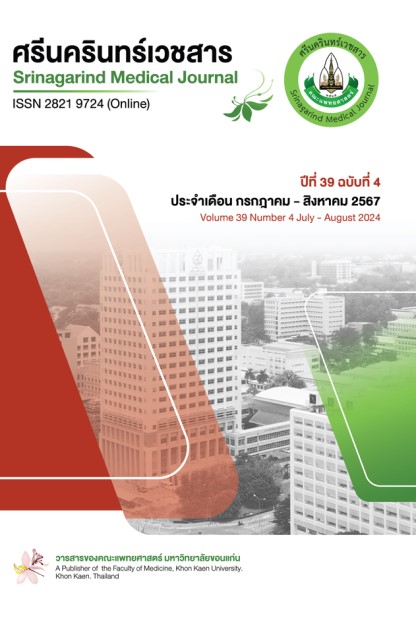HPV and Head and Neck Cancers: The Importance of Viral Strains on Clinical Characteristics, Prognosis, and Use as Biomarkers.: Review article
Keywords:
head and neck cancer, human papillomavirus, HPV16, oropharyngeal cancer, prognosis, biomarker, p16 staining, HPV ctDNA, HPV E6/E7 antibodiesAbstract
Head and neck cancers are common malignancies with high mortality rates. Currently, human papillomavirus (HPV) infection has been identified as a significant cause of these cancers, particularly in the oropharynx. This study aimed to review the relationship between HPV strains and the development of head and neck cancers, as well as the clinical characteristics, prognosis of HPV-associated cancers, and advancements in HPV detection techniques.
Studies have found that HPV16 is the most prevalent strain in head and neck cancers (90%), particularly in oropharyngeal cancer, followed by HPV18 (2.5-5%) and other high-risk HPV strains such as HPV31, 33, 35, and 45. Furthermore, there are differences in clinical characteristics and prognosis between HPV-positive and HPV-negative cancers. HPV-positive cancers often occur in younger, non-smoking patients and exhibit early lymph node metastasis. However, they respond better to treatment and have higher survival rates compared to HPV-negative cancers. Nonetheless, it remains unclear whether different HPV strains have varying effects on prognosis.
Given the crucial role of HPV in head and neck cancers, detecting HPV in tumor tissues is highly beneficial for treatment planning and prognostication. Current techniques is p16 staining. Additionally, efforts are being made to develop blood-based HPV biomarker tests, such as circulating HPV DNA (ctDNA) or HPV E6/E7 antibodies, for non-invasive diagnosis and monitoring. However, further studies are required before these techniques can be implemented in clinical practice.
In summary, HPV plays a significant role in the development of head and neck cancers, particularly HPV16 in oropharyngeal cancer. Clinical characteristics and prognosis differ between HPV-positive and HPV-negative cancers. HPV detection in tumors is useful for treatment planning, and there is a trend towards developing blood-based HPV biomarker tests for disease monitoring in the future, which will enhance the effectiveness of patient care.
References
Bratman SV, Bruce JP, O'Sullivan B, Pugh TJ, Xu W, Yip KW, et al. Human papillomavirus genotype association with survival in head and neck squamous cell carcinoma. JAMA Oncol 2016;2(6):823-6. doi:10.1001/jamaoncol.2015.6587
Spence T, Bruce J, Yip KW, Liu FF. HPV associated head and neck cancer. Cancers (Basel) 2016;8(8):75. doi:10.3390/cancers8080075
Boscolo-Rizzo P, Polesel J, Del Mistro A, Fratta E, Lazzarin C, Menegaldo A, et al. Rising trend in the prevalence of HPV-driven oropharyngeal squamous cell carcinoma during 2000-2022 in Northeastern Italy: implication for using p16INK4a as a surrogate marker for HPV-driven carcinogenesis. Cancers (Basel) 2023;15(9):2643. doi:10.3390/cancers15092643
Castellsagué X, Alemany L, Quer M, Halec G, Quirós B, Tous S, et al. HPV involvement in head and neck cancers: comprehensive assessment of biomarkers in 3680 patients. J Natl Cancer Inst 2016;108(6):djv403. doi:10.1093/jnci/djv403
Haring CT, Rocco JW. Emerging role of blood-based biomarker testing in HPV-mediated head and neck squamous cell carcinoma. Cancer Cytopathol 2024;132(1):7-9. doi:10.1002/cncy.22735
Kobayashi K, Hisamatsu K, Suzui N, Hara A, Tomita H, Miyazaki T. A review of HPV-related head and neck cancer. J Clin Med 2018;7(9):241. doi:10.3390/jcm7090241
Garset-Zamani M, Carlander AF, Jakobsen KK, Friborg J, Kiss K, Marvig RL, et al. Impact of specific high-risk human papillomavirus genotypes on survival in oropharyngeal cancer. Int J Cancer 2022;150(7):1174-83. doi:10.1002/ijc.33893
Sharkey Ochoa I, O'Regan E, Toner M, Kay E, Faul P, O'Keane C, et al. The role of HPV in determining treatment, survival, and prognosis of head and neck squamous cell carcinoma. Cancers (Basel) 2022;14(17):4321. doi:10.3390/cancers14174321
Chera BS, Kumar S, Shen C, Amdur R, Green R, Goldman JW, et al. Plasma circulating tumor HPV DNA for the surveillance of cancer recurrence in HPV-associated oropharyngeal cancer. J Clin Oncol 2020;38(10):1050-8. doi:10.1200/JCO.19.02444
Wai KC, Strohl MP, van Zante A, Ha PK. Molecular diagnostics in human papillomavirus-related head and neck squamous cell carcinoma. Cells 2020;9(2):500. doi: 10.3390/cells9020500
Galati L, Chiocca S, Duca D, Tagliabue M, Simoens C, Gheit T, et al. HPV and head and neck cancers: Towards early diagnosis and prevention. Tumour Virus Res 2022;14:200245. doi: 10.1016/j.tvr.2022.200245 doi:10.1016/j.tvr.2022.200245
Downloads
Published
How to Cite
Issue
Section
License
Copyright (c) 2024 Srinagarind Medical Journal

This work is licensed under a Creative Commons Attribution-NonCommercial-NoDerivatives 4.0 International License.




